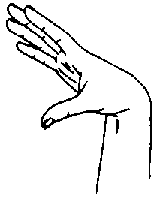



![initial position of [flick index finger] handshape illustrated](/handshape/cockedindexfinger.jpg)
![final position of [flick index finger] handshape illustrated](/handshape/indexfingerb.jpg)
![[horns] handshape illustrated](/handshape/horns1.jpg)



Footnotes
2. As described in Baker-Shenk, C. & D. Cokely (1991). Clerc. ISBN 093032384X.
3. Türk İşaret Dili | Turkish Sign Language.
Created 24 May 1999, links updated monthly with the help of LinkAlarm.




![initial position of [flick index finger] handshape illustrated](/handshape/cockedindexfinger.jpg)
![final position of [flick index finger] handshape illustrated](/handshape/indexfingerb.jpg)
![[horns] handshape illustrated](/handshape/horns1.jpg)



Footnotes
2. As described in Baker-Shenk, C. & D. Cokely (1991). Clerc. ISBN 093032384X.
3. Türk İşaret Dili | Turkish Sign Language.
